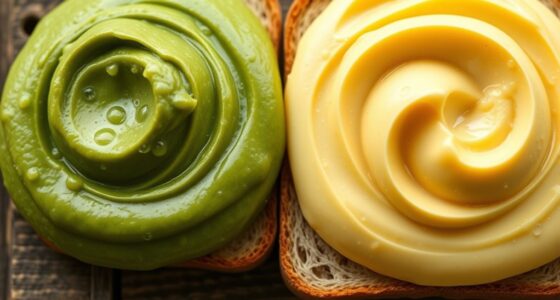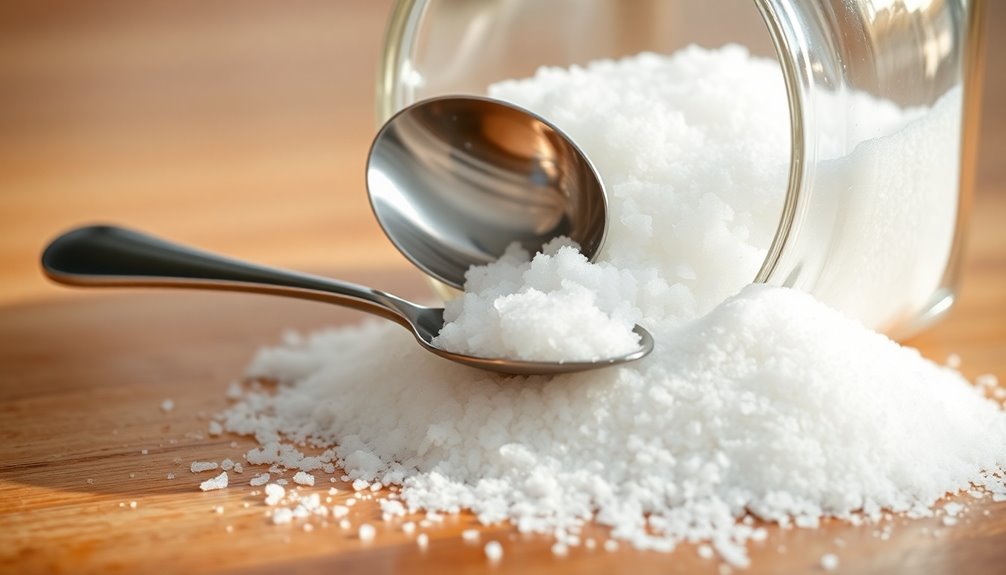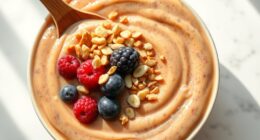39 grams of sugar is about 9.75 teaspoons, which is quite a bit more than you might realize. For context, dietary guidelines suggest women should limit added sugars to 6 teaspoons and men to 9 teaspoons daily. Consuming 39 grams puts you over these limits, potentially leading to health issues like weight gain and increased risk of diabetes. Common sources include sugary drinks and processed foods, often masking their sugar content. Understanding these measurements and how they fit into your diet can help you make better choices. Stay tuned to discover more insights on managing your sugar intake effectively!
Key Takeaways
- 39 grams of sugar is approximately 9.75 teaspoons, significantly impacting daily intake recommendations.
- Women should limit added sugars to 6 teaspoons; 39 grams exceeds this guideline.
- Consuming 39 grams of sugar contributes to the average American's daily intake of 72.3 grams.
- High sugar intake is linked to health issues like weight gain and diabetes risk.
- Monitoring sugar consumption, including 39 grams, aids in making healthier dietary choices.
Understanding Sugar Measurements
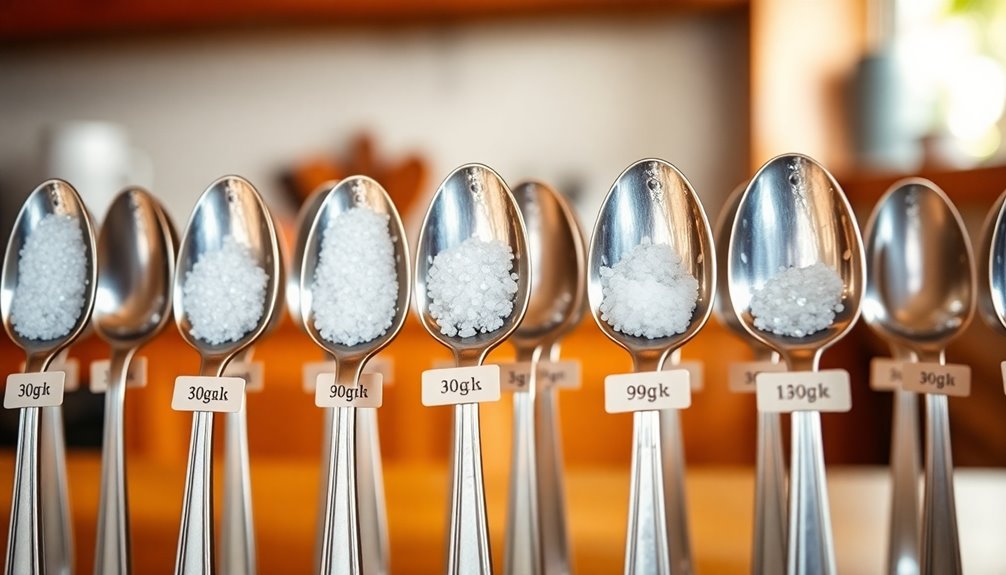
When it comes to managing your sugar intake, understanding how grams convert to teaspoons is essential. Grams are a measure of weight, while teaspoons measure volume, and knowing that 4 grams of sugar equals about 1 teaspoon helps you visualize your consumption better.
Nutrition Facts labels often list sugar content in grams, so dividing the grams by 4 gives you a clearer picture of how much sugar you're actually consuming in teaspoons.
For example, if you see a beverage with 65 grams of sugar, that means you're looking at about 16 teaspoons of added sugars. This conversion highlights how quickly total sugars can add up, especially from processed foods and drinks.
Being aware of how grams translate into teaspoons empowers you to make informed choices about your sugar intake.
Daily Sugar Intake Recommendations
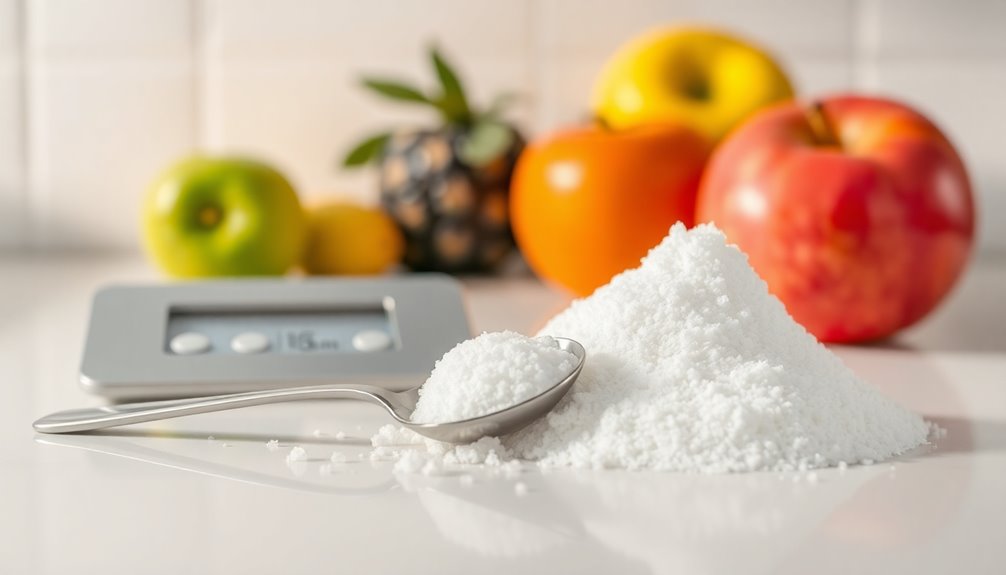
Daily sugar intake recommendations provide essential guidance for maintaining a balanced diet and promoting overall health. It's important to know how much added sugar you should limit in your daily diet. The American Heart Association and Dietary Guidelines for Americans offer clear suggestions:
- For Women: Limit added sugars to no more than 6 teaspoons (25 grams or 100 calories) per day.
- For Men: Aim to keep added sugars at 9 teaspoons (36 grams or 150 calories) daily.
- For Children (Aged 2-18): Keep it under 6 teaspoons (24 grams) per day, with sugary beverages capped at 8 ounces per week.
These recommendations guarantee that added sugars make up less than 10% of your total daily caloric intake, which translates to about 50 grams for a 2,000-calorie diet.
However, recent data reveals that the average American adult consumes around 72.3 grams (18 teaspoons) of added sugars daily, greatly exceeding these recommended limits.
Major Sources of Added Sugar

Understanding daily sugar intake recommendations is essential, but knowing where added sugars come from can help you make better food choices. One of the major sources of added sugars in your diet is sugar-sweetened beverages. Just one 12-ounce can of soda can pack about 10 teaspoons of added sugar. Additionally, beverages like coffee can be a healthier alternative when consumed without added sugars, as they contain beneficial compounds. Incorporating essential oils into your daily routine can provide natural flavoring options without the added sugar. It's worth noting that some juices, like celery juice, are not only low in sugar but also packed with nutrients beneficial for overall health, making them a great choice compared to sugar-sweetened beverages.
You might think fruit juices are a healthier option, but many contain even more added sugar per serving than soft drinks.
Sweet snacks, such as cookies, cakes, and pastries, are also significant contributors to your daily sugar intake. Granola bars and flavored yogurts often contain high levels of added sugars as well, sometimes exceeding 10 grams per serving.
It's easy to overlook how quickly these teaspoons of added sugar can add up, pushing you beyond the daily recommendations. Consuming high amounts of sugar can lead to increased health risks, making it crucial to monitor your intake.
To make healthier choices, start by checking labels for added sugars in your favorite snacks and drinks. If you're consuming around the average of 17 teaspoons of added sugar daily, you'll want to be mindful of these major sources and consider reducing your intake for a healthier lifestyle.
Health Effects of Excess Sugar
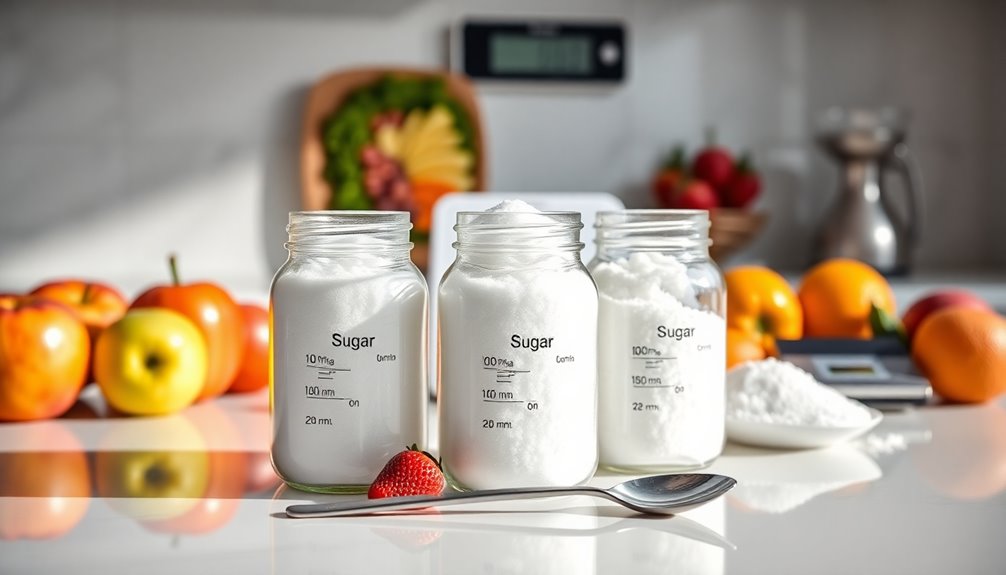
Excess sugar intake poses serious health risks that can impact your long-term well-being. The American Heart Association recommends limiting added sugars to 6 teaspoons for women and 9 teaspoons for men. Yet, the average American consumes about 17 teaspoons daily, which can lead to significant health effects.
Here are three major health risks associated with excessive sugar consumption:
- Cardiovascular Disease: High sugar intake is linked to an increased risk of heart issues. The more added sugars you consume, the higher the likelihood of developing cardiovascular diseases.
- Obesity: Sugary beverages, in particular, contribute to weight gain. Just one soda a day can lead to a potential 15-pound increase over three years due to excess calories per serving.
- Diabetes: Regularly consuming high amounts of added sugars can increase your chances of insulin resistance, paving the way for diabetes.
Monitoring your sugar intake is essential. Reducing added sugars not only benefits your waistline but also helps protect against diabetes and cardiovascular diseases, ensuring better overall health.
Consider making small changes to your diet today!
Converting Grams to Teaspoons
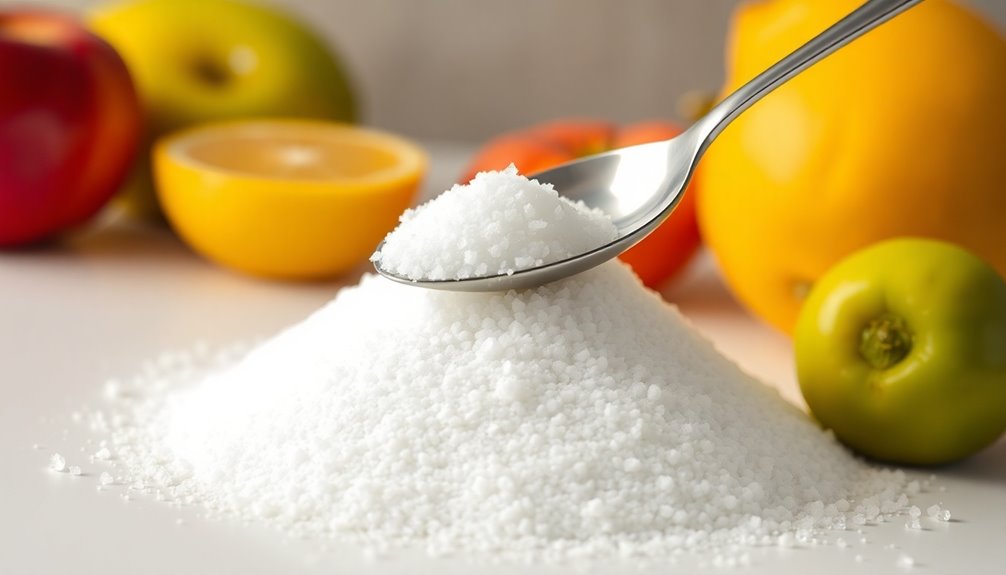
When you're trying to manage your sugar intake, understanding how to convert grams to teaspoons can be really helpful.
For instance, if you see a product with 39 grams of sugar, you now know that's about 9.75 teaspoons.
This practical knowledge can make a big difference in tracking your daily consumption and adhering to recommended limits.
Understanding Measurement Differences
- Grams vs. Teaspoons: Grams measure weight, while teaspoons measure volume. This means that food manufacturers often label sugar content in grams, making conversions necessary for you to visualize how much that's in teaspoons of sugar.
- Conversion Simplified: To convert grams of added sugar to teaspoons, simply divide the grams by 4. For example, if a beverage has 20 grams of sugar, that's about 5 teaspoons of sugar (20 ÷ 4 = 5).
- Nutrition Labels: Many nutrition labels round down sugar content for simplicity. Remember, 4 grams of sugar is roughly equal to one teaspoon, making it easier for you to track your intake. Additionally, being aware of your budget can help you manage dietary choices that affect overall health.
Practical Conversion Examples
Converting grams of sugar to teaspoons is straightforward and vital for managing your sugar intake. To make the conversion, simply divide the number of grams by 4, as there are about 4 grams of sugar in a teaspoon.
For example, if you're looking at a beverage with 20 grams of sugar, you'll find it contains roughly 5 teaspoons (20g ÷ 4 = 5 tsp).
Nutrition labels often round down to 4 grams for simplicity, so it's important to understand this conversion for effective sugar monitoring.
Take an average 20-ounce sugar-sweetened beverage, which has around 65 grams of sugar; this equates to about 16.25 teaspoons (65g ÷ 4 = 16.25 tsp).
Daily Intake Implications
Understanding the implications of daily sugar intake becomes clearer when you convert grams to teaspoons, as this visual representation can help you make informed dietary choices.
The American Heart Association recommends limiting added sugars to 6 teaspoons (25 grams) per day for women and 9 teaspoons (36 grams) for men. Water efficiency is an important concept to consider for overall health. Additionally, maintaining high vibrational energy can support healthier dietary choices. A low carb diet can also help in reducing cravings for sugary foods, making it easier to stay within these limits. Incorporating a balanced diet rich in fruits and vegetables can further support your overall health.
Here's how you can assess your intake:
- Check beverage labels: A drink with 65 grams of added sugar means you're consuming about 16 teaspoons—far exceeding daily limits.
- Mind the sugary drinks: Drinking just two sugary beverages can push women over their daily intake, leading to excess total calories and potential health issues.
- Track your intake: The average American consumes around 17 teaspoons daily, showing a clear need for awareness and moderation. Additionally, excessive sugar consumption can contribute to physical and mental health issues such as fatigue and mood swings.
Reading Nutrition Labels

When you read nutrition labels, it's essential to understand the difference between total sugars and added sugars.
Check the serving size to see how much sugar you're actually consuming in each portion.
Understanding Added Sugars
Understanding added sugars is crucial, as excessive intake can lead to various health issues, including the risk of illness. In addition, keeping track of your overall sugar consumption can be beneficial for air quality since high sugar diets have been linked to inflammation, which can negatively affect respiratory health. Additionally, managing your sugar intake is vital for maintaining financial health as it can impact healthcare costs associated with chronic diseases.
Interpreting nutrition labels can be tricky, especially when it comes to added sugars. Understanding how to identify these sugars is essential for managing your daily calorie intake.
Added sugars are those sugars not naturally occurring in food, like white sugar, brown sugar, honey, and corn syrup. The American Heart Association (AHA) recommends limiting added sugars to 6 teaspoons (25 grams) per day for women and 9 teaspoons (36 grams) for men to help reduce the risk of chronic diseases.
Here are three tips to help you navigate added sugars:
- Check the Nutrition Facts: Look for the "Added Sugars" line under total sugars on the label. This gives you the total amount of added sugars in the product.
- Read Ingredient Lists: Ingredients are listed in descending order by weight. If sugar appears near the top, the product likely has a high added sugar content.
- Convert Grams to Teaspoons: Remember, to visualize your intake, divide the total grams by 4. This helps you understand how much sugar you're consuming in teaspoons.
Interpreting Serving Sizes
Serving sizes on nutrition labels play an essential role in helping you gauge how much added sugar you're really consuming. By carefully examining the serving sizes, you can better understand the amount of Total Sugars and Added Sugars in a product.
Remember, added sugars are included in the total carbohydrates, which means they're distinct from naturally occurring sugars.
To make informed choices, always check the grams of sugar and convert them to teaspoons for a clearer perspective; simply divide grams by 4. For instance, if a product has 20 grams of sugar, that equates to 5 teaspoons.
Another key aspect is the Percent Daily Value (%DV) for added sugars. If you see 5% DV or less, you're looking at a low-sugar option, while 20% DV or more indicates a high level of added sugars.
This information guides you toward healthier options.
Tips for Reducing Sugar Intake
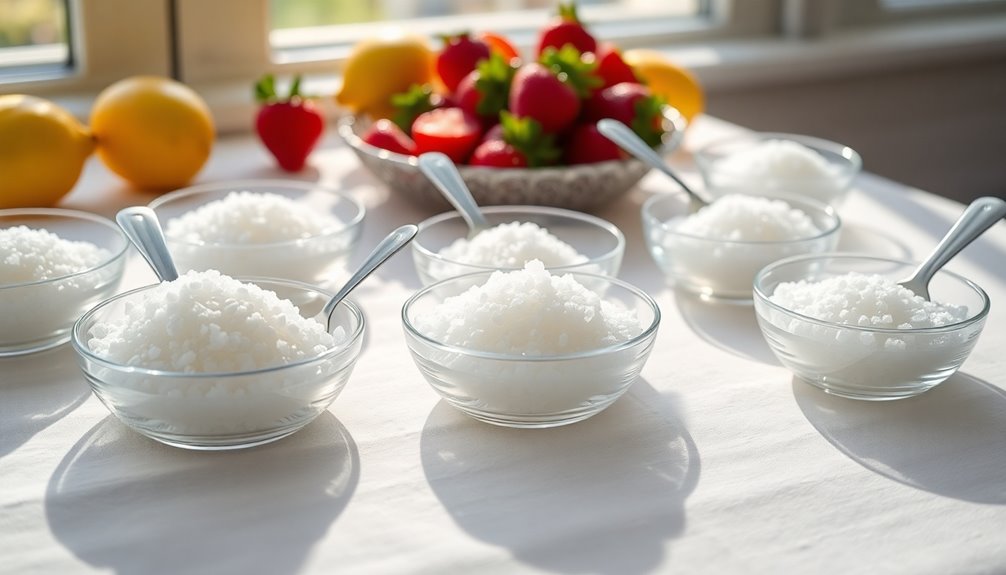
Reducing your sugar intake can greatly improve your overall health and well-being. By being mindful of added sugars in your diet, you can make significant changes. Here are some practical tips to help you limit added sugars:
- Read Nutrition Labels: Always check nutrition labels when shopping. A product is considered high in added sugar if it contains 20% or more of your daily value per serving. This helps you avoid hidden sugars in packaged foods. Additionally, being aware of the importance of socialization for your pets can help you make healthier lifestyle choices, including your diet. Regularly choosing HEPA filters can also promote better indoor air quality, supporting overall health. Improved air quality can reduce respiratory health issues and contribute to better overall well-being.
- Choose Whole Foods: Opt for whole foods over processed options. Many flavored yogurts and granola bars are packed with added sugars. Instead, focus on fresh fruit, which provides natural sweetness without the extra sugar.
- Swap Sugary Beverages: Replace sugary drinks with water, tea, or coffee. A single 20-ounce sugar-sweetened beverage can pack around 65 grams (16 teaspoons) of sugar—well above your daily limit! Additionally, incorporating fresh fruit juices can provide natural sweetness and essential nutrients without the added sugars found in many beverages. Moreover, choosing energy-efficient models can also reduce costs while improving your overall health through better air quality.
Making Informed Food Choices
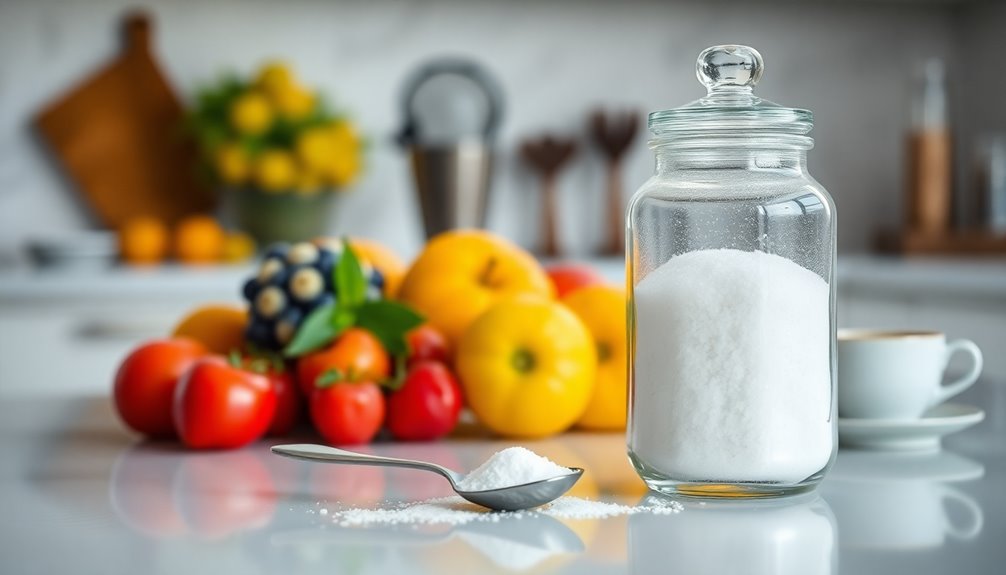
Making informed food choices is essential for maintaining a healthy diet and overall well-being. Start by understanding the difference between total sugars and added sugars on nutrition labels. This distinction helps you manage the amount of sugar per serving, making it easier to avoid excess intake.
For instance, many processed foods, like breakfast cereals and flavored yogurts, often contain significant added sugars. When you see a label, aim for products that contain 5% daily value (DV) or less of added sugars per serving, indicating they're low in added sugar. In contrast, anything with 20% DV or more is high and should be consumed sparingly.
Be especially cautious with sugar-sweetened beverages. A 20-ounce drink can pack around 65 grams of sugar, which is about 16 teaspoons! These liquid sugars can quickly exceed your daily limits if you're not careful.
Frequently Asked Questions
How Many Teaspoons of Sugar Is Healthy per Day?
You should aim to limit your daily added sugar intake to about 6 teaspoons (25 grams) if you're a woman, and 9 teaspoons (36 grams) if you're a man, according to the American Heart Association.
For a balanced diet, try to keep added sugars below 10% of your total daily calories.
For children aged 2-18, it's best to restrict added sugars to less than 6 teaspoons per day to promote better health.
Is 1 Teaspoon of Sugar a Day Bad for Weight Loss?
One teaspoon of sugar a day isn't necessarily bad for weight loss, but it's still important to contemplate your overall sugar intake.
If you're consuming other sugary foods, that one teaspoon can add up. It might trigger cravings and increase your appetite, making it harder to stick to your goals.
Focus on whole, unprocessed foods instead, and try to limit added sugars for better results on your weight loss journey.
How Much Sugar Is Healthy for a Diet?
To maintain a marvelous, mindful diet, you should limit added sugars. Stick to about six teaspoons for women and nine for men daily.
Silencing sugary snacks can save your health, reducing risks of serious issues like obesity and diabetes.
So, survey your snacks and drinks; they often hide harmful amounts of sugar. Stay aware, stay balanced, and savor natural sweetness from fruits instead.
Your body will thank you for it!
What Does 1g of Sugar Look Like?
When you think about 1 gram of sugar, it's roughly a quarter of a teaspoon.
That tiny amount may not seem like much, but it's crucial to recognize how quickly those grams add up in your diet.
If you're monitoring your sugar intake, visualize that quarter teaspoon when you see sugar on food labels.
It helps you understand just how much sugar you're consuming in snacks and drinks throughout the day.
Conclusion
To sum up, while you might think 39 grams of sugar isn't a big deal, it can add up quickly and impact your health more than you realize. You deserve to feel your best, and cutting back on added sugars can boost your energy and mood. Remember, it's not about deprivation; it's about making smarter choices. By staying informed and mindful, you can enjoy delicious foods without compromising your well-being. Your body will thank you!



